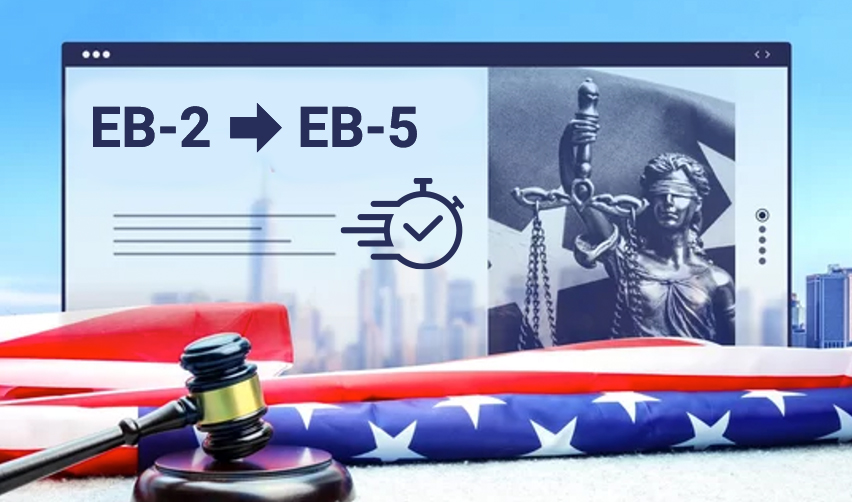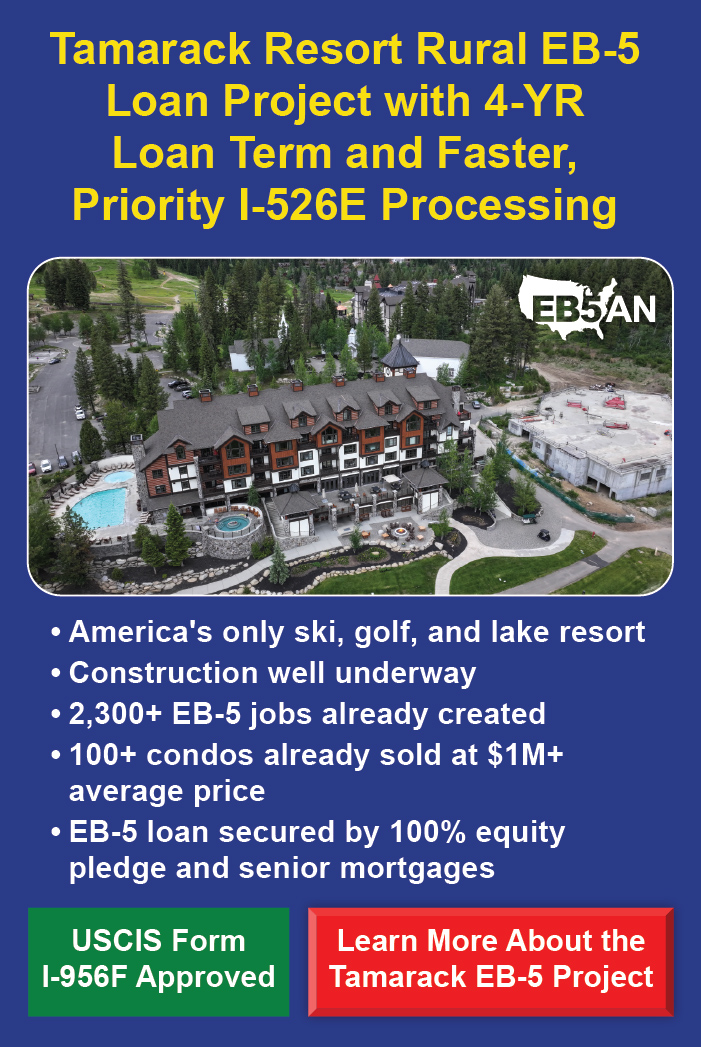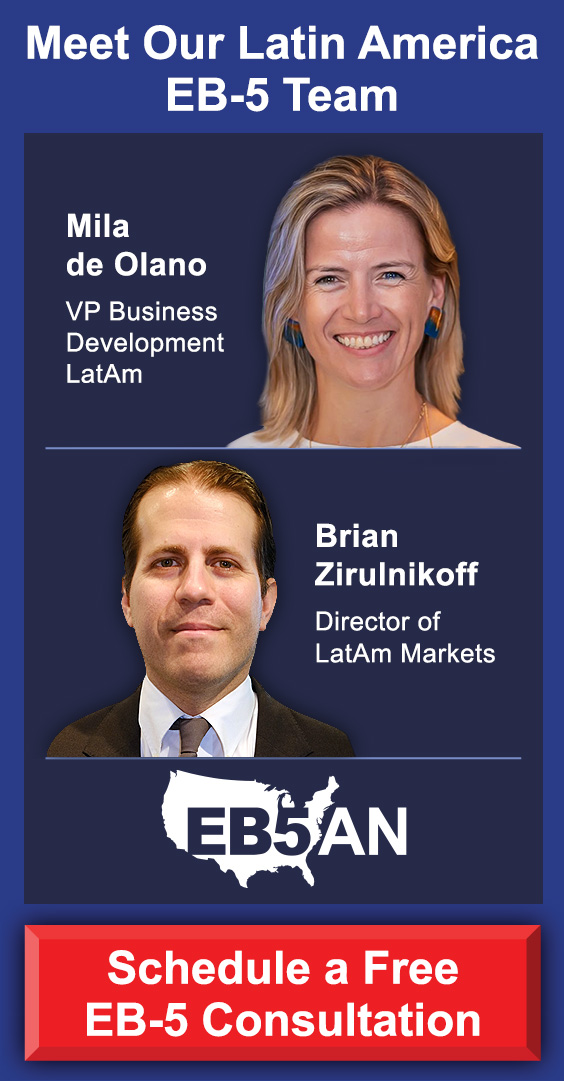For Indian nationals in the EB-2 Visa queue, waiting for green card approval can take decades. An EB-2 Visa also requires sponsorship by a U.S. employer, which is a lengthy process.
Even when Indian nationals are able to secure an EB-2 Visa, they are usually tied to their sponsoring employer and specific job role during the green card application process.
This is why Indian EB-2 Visa applicants should consider switching to the EB-5 Visa Program. An EB-5 Visa offers a much faster and more reliable path to obtaining a green card.
EB-5 applicants can also quickly obtain an employment authorization document (EAD) and continue to live and work anywhere in the United States while they wait for their green card.
An EB-5 Investor’s Story: Ram From India
Take a look at our recent interview with Ram, an investor in our Twin Lakes Georgia EB-5 Project. A former EB-2 applicant, Ram investigated how long the EB-2 immigration process would typically take and determined that EB-5 was a much faster and safer option. His experience can provide helpful guidance for Indian nationals who are considering either the EB-2 or EB-5 pathways.
In this article, we summarize many of the points discussed in the interview with Ram, and provide EB-2 applicants with an idea of the timeframe that they can expect for their immigration process.
Understanding the Supply and Demand of EB-2 Visas
The Long Wait: Analyzing the Approval Rate
The EB-5 Visa: A Faster Alternative for EB-2 Applicants
Why Choose the EB-5 Visa over the EB-2 Visa?
Making the Switch to the EB-5 Visa
How EB5AN Can Help You
The EB-5 Visa for Indian Nationals – Get Yours Today
Understanding the Supply and Demand of EB-2 Visas
The long wait for EB-2 Visa applicants can be ascribed to the imbalance between supply and demand. The supply refers to the number of visas issued for EB-2 Indian nationals, while the demand refers to the number of people applying for EB-2 visas from India.
In the table below we can see how many EB-2 Visas were issued per year.
In 2015, United States Citizenship and Immigration Services (USCIS) approved around 7,000 EB-2 Visa applications for Indian nationals. Since then, this number has been on a decline, with only about 2,500 applicants approved in 2020.
The lower numbers in 2020 and 2021 can be attributed to the COVID-19 pandemic, as there was an abundance of family-based visa applicants in the employment visa category.
In the best-case scenario, USCIS will return to processing about 7,000 applicants per year, but in the worst case, this number could be as low as 2,000 due to the current backlog.
On the demand side, the number of applicants waiting for their priority date to become current is higher compared to what it was in 2015.
Key Point: What Is a Priority Date?
The term “priority date” might seem complex, but its definition is rather straightforward. A priority date is when your country’s visa applications are being processed. In other words, this is the date when the U.S. Citizenship and Immigration Services (USCIS) starts processing your EB-5 Immigrant Investor Program petition (Form I-526).
USCIS gradually moves forward the cutoff date for EB-2 applicants. See this article for more information on how cutoff dates work.
Let’s say your priority date was set for December 2021. As you can see in the table below, at this point there were close to 440,000 other applicants ahead of you, all waiting to receive their green card via the EB-2 Visa option.
Let’s dive into the process of applying for a green card through the EB-2 category. One of the initial steps is to get your I-140 petition approved. For Indian investors, you’ll find that around 30,000 of these approvals are granted each year.
Now, let’s crunch some numbers. If we add up all these approvals until the end of 2021, we find that approximately 200,000 Indian applicants had their approvals in hand by December 31, 2021. But we need to consider some other factors as well. When we take into account their family members, and filter out duplicates and abandoned applications, this figure balloons to nearly 440,000.
In the case of Ram, he would have had to wait for a period of between 20 and 35 years to obtain his green card.
Investor Insight
Ram from India speaks about the long wait times and the decision to explore EB-5…
“I started looking into these numbers in mid-2022, but as late 2022 rolled in, there were tech layoffs. That made me eager to find out what the other legal pathways were to a green card given that I had to wait about 20 years (at a minimum) to get my green card through the EB-2 queue. I was just researching these pathways, and to be honest, the only other way that I found was EB-5.”
The Long Wait: Analyzing the Approval Rate
To better understand the waiting times, we can analyze the approval rate for different priority dates, by using the example of three different processing quantities for EB-2 Visas: 5,000, 7,000, and 10,000 per year.
For example, someone with a priority date of December 31, 2018, could expect to wait anywhere from 29 years (best case – if 10,000 applications are processed per year) to 59 years (worst case – if 5,000 applications are processed per year).
If an EB-2 applicant applied somewhat earlier—in 2017, for instance—their wait time would unfortunately not be much shorter. At the time of writing this article, EB-2 Visa applicants who filed their petitions in May 2017, have an approximate wait time of 20-35 years.
Maintaining employment, career level, and legal status in the U.S. during the lengthy waiting period poses significant challenges for applicants.
The uncertain waiting period restricts job flexibility and professional advancement opportunities as applicants are dependent on their sponsoring employers and are limited to specific roles.
Top Tip: Check the latest Visa Bulletin
The Visa Bulletin is a monthly publication issued by the U.S. Department of State that provides information about the availability of immigrant visa numbers.
It outlines the cutoff dates for each visa category and country of chargeability, and indicates whether a green card (permanent residency) is immediately available or if there is a waiting period.
The Visa Bulletin is divided into two main sections: “Final Action Dates” and “Dates for Filing.”
You can read the latest Visa Bulletin HERE.
The EB-5 Visa: A Faster Alternative for EB-2 Applicants
The EB-5 Visa offers a more direct route to a U.S. green card than the EB-2 Visa, by bypassing complex employer approval steps. This visa allows applicants to select their investment and job preferences.
Although the EB-5 requires a bigger investment, it can be recovered. Despite investment risks and the hands-on management requirement, its potential for immigration achievement and financial benefits make it appealing for those who seek more control over their permanent residency process.
EB-5 is for foreign investors capable of investing at least $800,000 in a U.S. business that creates a minimum of 10 full-time jobs for U.S. workers.
This visa category offers faster green card acquisition, with processing times generally between 2 to 5 years.
Why Choose the EB-5 Visa over the EB-2 Visa?
The EB-5 and EB-2 visas have different benefits to consider. Here are some reasons why someone might pick the EB-5 Visa instead of the EB-2 Visa:
| Faster Processing Times | The most important advantage of the EB-5 Visa is the quicker processing time compared to the EB-2 Visa. Applicants can obtain their green card in a matter of years rather than decades. |
| Flexibility in Career Path | Unlike the EB-2 Visa, which requires applicants to maintain their specific work level and employment status, the EB-5 Visa offers more freedom to pursue different career paths and business opportunities in the United States. |
| Greater Stability for Families | The EB-5 Visa allows applicants and their immediate family members (spouse and unmarried children under 21) to obtain their green cards simultaneously. This provides greater stability and peace of mind for families, as they can establish their lives in the U.S. without worrying about long waiting times and maintaining their legal status for decades. |
| No Visa Re-Stamping | With the EB-5 Visa, holders can travel in and out of the United States without the need for visa re-stamping. This eliminates the hassle and uncertainty associated with maintaining legal status while waiting for the EB-2 Visa to be approved. |
In addition, the EB-5 Reform and Integrity Act of 2022 (the “RIA”) offers Indian EB-5 investors an opportunity to bypass processing delays by investing in rural projects.
USCIS sets aside 20% of the total EB-5 Visa supply for rural TEA projects.
Key Point: What Is a Visa Set Aside?
A visa set aside is when some visas that have been reserved for a certain group or year aren’t used. These visas are saved for later. In U.S. immigration, there are limits applied each year for visas in different categories and for each country. If all the visas are not used, any extra visas are set aside for another time. These unused visas might be given out in the next year or to other groups with higher demand. It is important to note that numbers can change based on U.S. rules and how many people want them.
Foreign nationals who invest in EB-5 projects qualify for visas reserved for the EB-5 Visa category, which allows them to avoid cutoff dates and effectively skip the line ahead of investors who do not qualify for reserved visas. Rural projects also offer unique benefits, such as lower demand relative to the number of reserved visas available and priority processing, which make them an attractive option for foreign investors.
Making the Switch to the EB-5 Visa
Switching to an EB-5 Visa involves a few straightforward steps.
First, learn about the EB-5 Program and its investment options. Select a suitable project and invest the required amount, usually $800,000 or $1,050,000. Then, submit Form I-526 to show your investment intent.
Twin Lakes, Georgia – Explore This Award-winning EB-5 Investment Opportunity TODAY!
When it comes to choosing a project that resonates with your goals, we can recommend the Regional Center Projects that we have at EB5AN for an investment of $800,000.
One such investment which has and continues to be particularly successful, is the Twin Lakes, Georgia Project.
Twin Lakes is a rural TEA project that requires an $800,000 investment loan. 520 of the projected 1,300 homes in this development have already been sold.
Due to a partnership that exists between the Kolter Group—a highly reputable property development company—and EB5AN, Twin Lakes is an outstanding EB-5 investment opportunity.
Reach out to us at EB5AN to request all the relevant documentation and insights you need for this project, and learn what other Indian EB-5 investors have experienced with this project HERE.
Once Form I-526 has been approved, you’ll get a conditional green card, which allows you to live and work in the U.S. Then, maintain your investment and job creation for two years, and after that, submit Form I-829 to remove temporary conditions from your green card.
Upon approval of Form I-829, you’ll receive a permanent green card. If you’re eligible, you can later apply for U.S. citizenship. It’s a good idea to work with an experienced immigration attorney who has a solid understanding of immigration law, EB-5, and your particular immigrant visa category to guide you through each step.
Investor Insight
Ram from India advises other applicants to find the right immigration attorney…
“After realizing that an EB-2 Visa would take an unbelievably long time to process and approve, I started looking at alternative ways to get my green card.
I spent most of 2022 researching EB-5 online. A simple Google search made it look as though there were hundreds of EB-5 projects out there. The biggest decision-making areas as an EB-5 investor are finding the right immigration attorney and then the right regional center or project to work with.”
How EB5AN Can Help You
EB5AN is an EB-5 investment fund manager, USCIS-approved regional center operator, and immigration services consultancy. We help foreign investors obtain U.S. permanent residency through investments in U.S. business enterprises and real estate development projects within the guidelines of the EB-5 Program.
EB5AN can assist you, the EB-5 investor, in several valuable ways:
Expertise and guidance
EB5AN is well-versed in the complex EB-5 program rules and regulations. We can provide you with expert guidance, which ensures you understand the process, requirements, and potential challenges.
Project selection
EB5AN offers a range of pre-approved EB-5 investment projects that meet the EB-5 Program criteria. We can help you choose a project that aligns with your goals and investment preferences.
Investment structure
EB5AN can assist in structuring your investment to meet EB-5 requirements, which ensures it creates the necessary jobs and complies with USCIS guidelines.
I-526 petition
Our team can help you prepare and file your I-526 petition, including all the necessary documentation needed to support your investment and job creation plans.
Regional center expertise
If you’re investing through a regional center, EB5AN has extensive experience working with regional centers across the United States. This helps you navigate the process smoothly.
Job creation compliance
EB5AN can monitor your investment’s job creation progress to ensure it meets the required job creation goals, a crucial element for obtaining a green card.
I-829 petition
When it’s time to remove conditions from your green card, EB5AN can help you prepare and file your I-829 petition, which is used to demonstrate job creation success.
Legal support
We work alongside experienced immigration attorneys to provide comprehensive legal support throughout the EB-5 process.
Due diligence
EB5AN conducts due diligence on projects and regional centers to ensure they meet program requirements and provide you with accurate information to guide your investment decision.
Consultation and support
EB5AN offers consultation services to answer your questions and provide support at every stage of your EB-5 journey.
By partnering with EB5AN, you are ensuring that your investment aligns with program guidelines and this maximizes your chances of obtaining a U.S. green card. This means you can navigate the EB-5 process with confidence.
The EB-5 Visa for Indian Nationals – Get Yours Today
The EB-5 Visa is a highly attractive option for Indian nationals who are seeking U.S. permanent residency. Particularly beneficial for those who face prolonged waiting times in other visa categories, the EB-5 program offers a relatively quick way to obtain a green card. This becomes especially relevant given the large backlogs often experienced by Indian applicants in the EB-2 category.
By removing the need for employer sponsorship and job-related challenges, the EB-5 route empowers Indian investors with greater autonomy. The EB-5 Program’s investment opportunities not only align with the entrepreneurial spirit of many Indian nationals but also open doors to potential financial gains, depending on the investment project chosen.
The fact that immediate family members also qualify for green cards is a definite advantage, along with the access it provides to educational and other benefits, which makes this a highly attractive option for Indian nationals.
Ultimately, the EB-5 Visa stands out as an excellent choice by offering a complete solution that caters to the needs and goals of Indian nationals who are looking for a direct, efficient, and potentially profitable pathway to U.S. permanent residency.
For more information, schedule a free consultation with EB5AN or watch our recent investor interviews.











